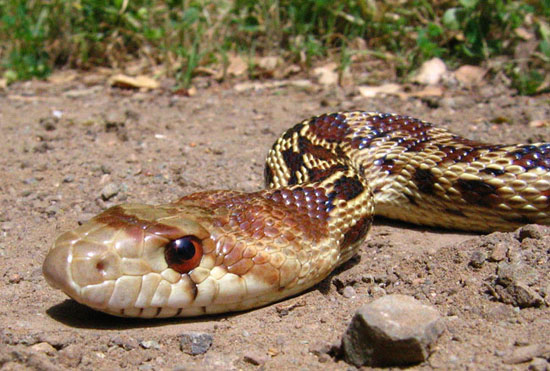Description
The Pacific Gopher Snake adults range in size from 2.5-7 feet (76-213 cm). However, most of the subspecies reach a length of 4.5-5 feet (137-152 cm). The hatchlings are relatively long, and they have been recorded at lengths upward of 20 inches (51cm).
The Pacific Gopher Snake has a base color ranging from yellow to dark brown and has a grey coloring on the sides of the body. It is a spotted snake, with the spots being dark brown. Usually there are 41 to 99 spots on the body, while the tail spots range from 14 to 33 spots. The side of the body shows 2 or 3 rows of alternating rows of black and brown spots.
A snake with keeled scales, and a narrow head that is wider than the neck, the Pacific Gopher Snake also displays a protruding rostral scale on the tip of the snout. The two most common base colors are straw and straw grey, though the species' color varies widely. The dorsal blotches, or saddles, are well-defined and generally dark to chocolate brown, though some specimens have had black blotches. The side blotches are often brown or grey. The back of the neck is dark brown. In many areas, such as Solano County, California, the snake can be found in a striped morph.
The ventral side may be cream-colored to yellowish with dark spots. On the dorsal side, especially near the tail, there is often a reddish coloration.
Identification
As aforementioned, there are 2 to 3 rows of spots on the side of the Pacific Gopher Snake. However, the San Diego Gopher Snake (P. c. annectens) has 3 to 4 rows of smaller spots on their sides. The Pacific Gopher Snake's saddle spots do not have the barren characteristic as the San Diego Gopher Snakes do. Also, the second row of spots are much larger on P.c. catenifer compared to P.c. annectens. Finally, the Pacific Gopher Snake generally has more saddle spots than the San Diego Gopher Snake.
Behavior
The snake is diurnal, though sometimes active at dusk and nocturnal during warm weather. They prefer drier habitats such as meadows, fields and agricultural farmland, and are seldom found in dense forests.
Like other gopher snakes, the Pacific gopher can produce a loud hiss when agitated or fearful. When threatened, this species will inflate its body, flatten its head, and vigorously shake its tail, which may produce a rattling sound if done in dry vegetation. However, Gopher snakes are generally good natured.
The Pacific Gopher Snake is a carnivore. Their diet consists of small mammals, notably pocket gophers; birds and their eggs; the occasional lizard and insect,and even bats. It is reputed to sometimes consume rattlesnakes.
 gopher snake the danger
gopher snake the danger
 gopher snake and lizards
gopher snake and lizards
 gopher snake
gopher snake
 gopher snake very big
gopher snake very big
 gopher snake
gopher snake
 gopher snake
gopher snake
 Gopher snake
Gopher snake
 Gopher snake
Gopher snake
No comments:
Post a Comment